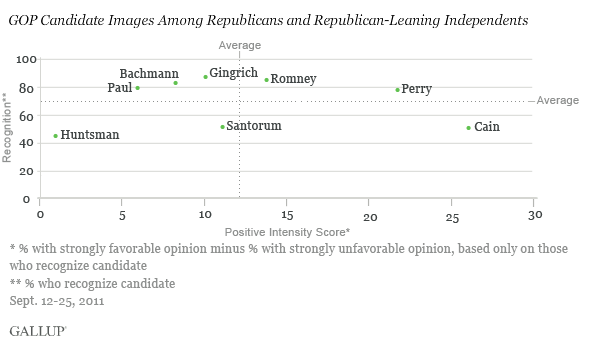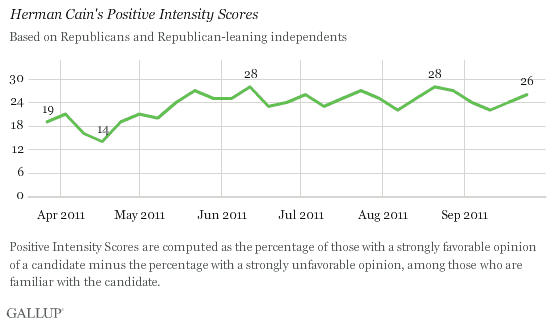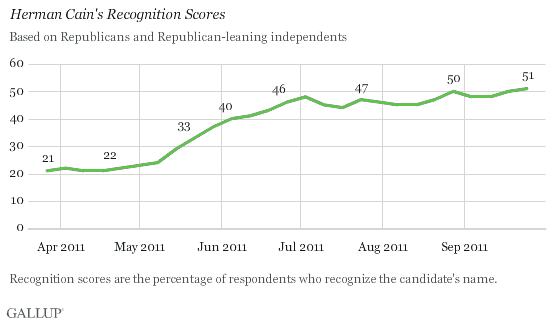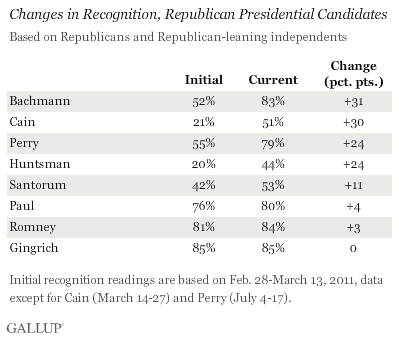PRINCETON, NJ -- Herman Cain's image among Republicans familiar with him is more intensely positive than any other Republican presidential candidate's, but his 51% name recognition continues to rank near the bottom of the field. Among the better-known candidates, Rick Perry has the strongest positive image.

Cain is attracting increased media attention after pulling off an upset in the Florida straw poll on Saturday. Much of the interviewing in the latest data, spanning Sept. 12-25 Gallup Daily tracking, was conducted before that win. However, Cain has consistently ranked near the top of Gallup's positive intensity list this year. His current score of 26 is just below the 28 he registered on two occasions, which is the highest Gallup has measured for any GOP candidate.

Whether the Florida result enhances Cain's image among Republicans will become apparent in the coming weeks. But Cain's image does not need as much improvement as does his name recognition. That has been an ongoing issue for the businessman best known as former CEO of the Godfather's Pizza chain.
Cain's name recognition increased from the low 20s in March to 40% in late May/early June, shortly after he announced his official candidacy. Since then, gains in recognition for Cain have been slower, increasing a total of 11 percentage points in the last four months.

As a result, Cain remains stuck in the second tier of candidates in terms of name recognition along with Jon Huntsman (44%) and Rick Santorum (53%), with the five other official candidates known by at least three-quarters of Republicans.
Cain's recognition remains low on a relative basis even though it has increased during the campaign more than any other candidate's except Michele Bachmann's. Cain started out at a low level of recognition, and his lack of further substantial gains in recent weeks has left him behind most other candidates.

The lack of name recognition may be one reason Cain has not fared well in recent Gallup presidential nomination preference polling. Cain has registered 4% or 5% of the vote in Gallup's monthly updates for July, August, and September. By comparison, Mitt Romney has averaged 21% support in those three updates even though his average Positive Intensity Score of 15 since July is nearly half of Cain's 25.
Implications
Cain's win in Florida may not be surprising in that he has always had a relatively small but intense following among Republicans, the kind of group that can propel a candidate to win a straw poll vote. His win may make him the new "flavor of the month" in the GOP nomination contest, which was the case for Bachmann in June after the first major candidate debate and for Perry in August after he officially announced his candidacy.
That status is not necessarily welcome news, though, as increased attention begets increased scrutiny, which can lead to increasingly negative views of the candidate. For example, Bachmann's current Positive Intensity Score of 8 is one-third as large as her score of 24 in late June. And though Perry remains among the most-liked candidates among those familiar with him, his score is beginning to show some signs of decline as his opponents have made his record and past statements a central theme of the campaign in recent weeks.
Even if Cain is able to weather increased scrutiny, he does have to convince voters that he is both electable and capable of being president, given his lack of political experience. However, with Americans expressing a low level of trust in government and the people who hold political office, they may view a lack of political experience as more of a plus than a minus.
Survey Methods
Results are based on telephone interviews conducted as part of Gallup Daily tracking Sept. 12-25, 2011, with random samples of Republicans and Republican-leaning independents, aged 18 and older, living in all 50 U.S. states and the District of Columbia. Questions asking about the 10 potential candidates measured in this research were rotated among randomly selected samples of Republicans each night; over the 14-day period, each candidate was rated by approximately 1,400 Republicans and Republican-leaning independents. (Results for Rudy Giuliani and Sarah Palin are not reported here.)
For the overall ratings of each potential candidate among Republicans and Republican-leaning independents, including recognition scores, one can say with 95% confidence that the maximum margin of sampling error is ±3 percentage points. For the Positive Intensity Score for each candidate, the maximum margin of sampling error varies depending on the size of the group recognizing the candidate.
Interviews are conducted with respondents on landline telephones and cellular phones, with interviews conducted in Spanish for respondents who are primarily Spanish-speaking. Each sample includes a minimum quota of 400 cell phone respondents and 600 landline respondents per 1,000 national adults, with additional minimum quotas among landline respondents by region. Landline telephone numbers are chosen at random among listed telephone numbers. Cell phone numbers are selected using random-digit-dial methods. Landline respondents are chosen at random within each household on the basis of which member had the most recent birthday.
Samples are weighted by gender, age, race, Hispanic ethnicity, education, region, adults in the household, and phone status (cell phone only/landline only/both, cell phone mostly, and having an unlisted landline number). Demographic weighting targets are based on the March 2010 Current Population Survey figures for the aged 18 and older non-institutionalized population living in U.S. telephone households. All reported margins of sampling error include the computed design effects for weighting and sample design.
In addition to sampling error, question wording and practical difficulties in conducting surveys can introduce error or bias into the findings of public opinion polls.
For more details on Gallup's polling methodology, visit www.gallup.com.
